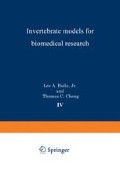Abstract
In this paper we intend to summarize briefly the main findings from our work on the inducible defense system of giant silk moths. This immunity manifests itself as a potent, cell-free antibacterial activity in the hemolymph (Boman et al., 1974a). A key tool for us has been an in vitro assay of bacterial killing measured by the loss of the colony forming ability. Our main test organism has been Escherichia coli, D31 (Boman et al., 1974). This strain carries resistance to streptomycin and ampicillin, properties which we have used both to eliminate any contaminating bacteria and for selective plating during double infections. Some of the parameters of our assay as well as its antibacterial spectrum have recently been discussed elsewhere (Rasmuson and Boman, 1977).
Access this chapter
Tax calculation will be finalised at checkout
Purchases are for personal use only
Preview
Unable to display preview. Download preview PDF.
References
Boman, H. G., Nilsson-Faye, I., Paul, K., and Rasmuson, T, Jr. (1974a). Insect immunity. I. Characteristics of an inducible cell-free antibacterial reaction in hemolymph of Samia cynthia pupae. Infect. Immun., 10, 136–145.
Boman, H. G., Nilsson-Faye, I., and Rasmuson, T, Jr. (1974b). Why is insect immunity interesting? p. 103–114. In: “Lipmann Symposium: Energy, Biosynthes is and Regulation in Molecular Biology,” (D. Richter, ed.). Walter de Gruyter Verlag, Berlin.
Briggs, J. D. (1958). Humoral immunity in lepidopterous larvae. J. Exp. Zoo l., 138, 155–188.
Chadwick, J. S. (1975). Hemolymph changes with infection or induced immunity in insects and ticks, p. 241–271. In: “Invertebrate Immunity,” (K. Maramorosch and R. E. Shope, eds.) Academic Press, New York.
Edlund, T., Siden, I., and Boman, H. G. (1976). Evidence for two immune inhibitors from Bacillus thuringiensis interfering with the humoral defense system of Saturniid pupae. Infect. Irrmrrun., 14, 934–941.
Faye, I., Pye, A., Rasmuson, T., Boman, H. G., and Boman, I. A. (1975). Insect immunity. II. Simultaneous induction of antibacter ial act iv ity and selective synthesis of some hemolymph proteins in diapausing pupae of Hyalophora cecropia and Samia cynthia. Infect. Immun., 12, 1426–1438.
Faye, I. (1978). Insect immunity: Early fate of bacteria inj ected in Saturniid pupae. J. Invertebr. Pathol. 31, 19–26.
Gingrich, R. E. (1964). Acquired humoral immune response of the large milkweed bug, Onocpeltus fasciatus (Dallas), to injected materials. J. Insect. Physiol., 10, 179–194.
Hink, W. F. (1970). Immunity in insects. Transplantation Proceedings, 2, 233–235.
Hink, W. F. and Briggs, J. D. (1968). Bactericidal factors in hemolymph from normal and immune wax moth larvae, Galleria mellonella. J. Insect. Physiol., 14, 1025–1034.
Kawarabata, T. (1970). Studies of an ac quiredresistance on microbial infections in the silkworm (Bombyx mori L.). J. Facult. Agric., Kyushu Univ., 24, 231–254 (in Japanese with English summary).
Kawarabata, T. (1971). Effect of vaccines on the production of bactericidal activity and hemolymph lysozyme level in the silkworm (Bombyx mori L.). J. Facult. Agric., Kyushu Univ., 16, 511–517.
Kinoshita, T. and Inoue, K. (1977). Bactericidal activity of the normal, cell-free hemolymph of silkworms (Bombyx mori). Infect. Immun., 16, 32–36.
Mohrig, W. and Messner, B. (1968). Immunreaktionen bei Insekten. I. Lysozym als grundlegender antibakterieller Faktor im humoralen Abwehrmechanismus der Insekten. Biol. Zb l., 87, 439–470.
Natori, S. (1977). Bactericidal substances induced in the hemolymph of Sarcophaga peregrina larvae. J. Insect Physio l., in press.
Powning, R. F. and Davidson, W. J. (1976). Studies on insect bacteriolytic enzymes-II. Some physical and enzymatic propert ies of lysozyme from hemolymph of Galleria mellone l la. Comp. Biochem. Physiol., 55B, 221–228.
Prehm, P., Stirm, S., Jann, B., Jann, K., and Boman, H. G. (1976). Cell-wall lipopolysaccharides of ampicillinresistant mutants of Escherichia coli K-12. Eur. J. Biochem., 66, 369–377.
Pye, A. E. and Boman, H. G. (1977). Insect immunity. III. Purification and partial characterization of immune protein P5 from hemolymph of Hyalophora cecropia pupae. Infect. Immun., 16, 408–414.
Rasmuson, T. and Boman, H. G. (1977). The assay and the specificity problem in insect community. In: “Developmental Immunobiology,” (J. B. Solomon and J. Horton, eds.). NorthHolland Biomedical Press, Amsterdam.
Stephens, J. S. and Marshall, J. H. (1962). Some properties of an immune factor isolated from the blood of actively immunized wax moth larvae. Can. J. Microbiol., 8, 719–725.
Telfer, W. H. and Williams, C. M. (1960). The effects of diapause, development, and injury on the incorporation of radioactive glycine into the blood proteins of the Cecropia silkworm. J. Insect. Physiol., 5, 61–72.
Author information
Authors and Affiliations
Editor information
Editors and Affiliations
Rights and permissions
Copyright information
© 1978 Springer Science+Business Media New York
About this chapter
Cite this chapter
Boman, H.G., Faye, I., Pye, A., Rasmuson, T. (1978). The Inducible Immunity System of Giant Silk Moths. In: Bulla, L.A., Cheng, T.C. (eds) Invertebrate Models for Biomedical Research. Comparative Pathobiology, vol 4. Springer, Boston, MA. https://doi.org/10.1007/978-1-4757-1278-0_9
Download citation
DOI: https://doi.org/10.1007/978-1-4757-1278-0_9
Publisher Name: Springer, Boston, MA
Print ISBN: 978-1-4757-1280-3
Online ISBN: 978-1-4757-1278-0
eBook Packages: Springer Book Archive

